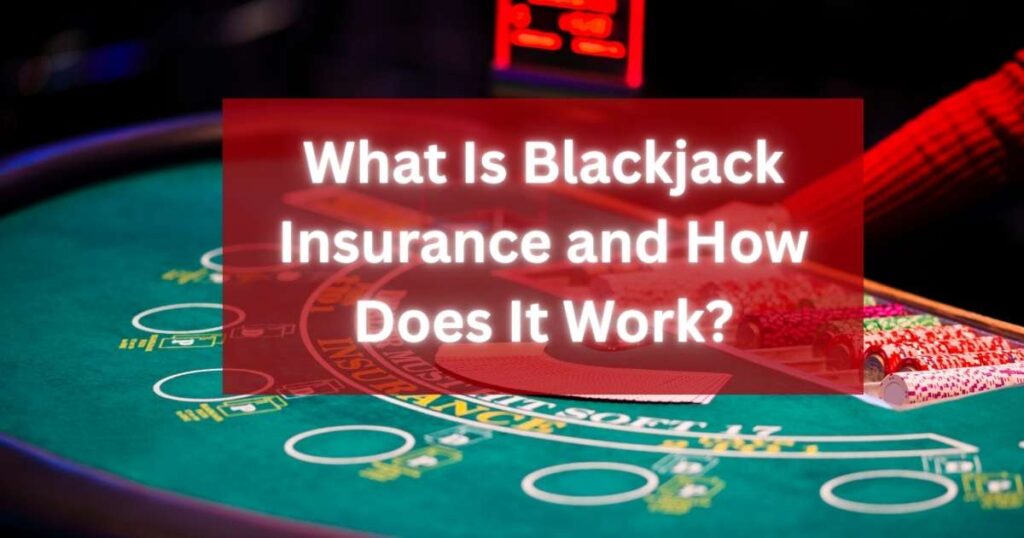This guide breaks down how insurance works, when it pays off and when it doesn’t.
What Is Blackjack Insurance and How Does It Work?
Blackjack Insurance Explained: Is It Ever Worth Taking?
Blackjack is one of the most beloved card games in the world—combining fast-paced action, strategy, and luck. But one decision still stumps even seasoned players: Should you take insurance?
In this quick guide, we’ll break down what blackjack insurance is, how it works, and why it’s one of the most misunderstood (and misplayed) side bets in the game.

Blackjack Insurance Explained
What Happens When the Dealer Shows an Ace?
When the dealer’s face-up card is an ace, players are given the opportunity to place a side bet called insurance.
- Purpose: It’s a bet that the dealer’s hidden card is a 10-point card (10, Jack, Queen, or King), giving them a natural blackjack.
- Wager: You can bet up to half your original wager.
- Outcome: If you’re right, insurance pays out 2:1. If you’re wrong, you lose the side bet, and the hand continues as normal.
Visual Guide to Blackjack Insurance
Your hand: 9♠ 8♣ (Total: 17)
Dealer shows: A♦ (Offers Insurance)
You bet: $10 (main) + $5 (insurance)
⬇
Dealer's face-down card: J♥ → Blackjack!
Result:
- You lose your main $10 bet
- You win $10 on insurance (2:1 payout on $5)
- Net result: Break-even
When Insurance Pays Out (and When It Doesn’t)
| Scenario | Insurance Bet | Main Bet | Net Outcome |
|---|---|---|---|
| Dealer has blackjack | Wins 2:1 | Lost | Break-even |
| Dealer doesn’t have blackjack | Lost | Play continues | Down half bet |
| You have blackjack too | Push | Push | Even money |
When Should You Consider Taking Insurance?
For Casual Players: ❌
Insurance, statistically speaking, is a losing bet over the long haul. In a normal 6-deck game, the actual chance of a dealer having a 10 under an Ace is only about 30.8%. That means you will lose insurance bets more than 2/3 of the time.
For Card Counters: Sometimes
Card counters, who are pros, can estimate how many 10-value cards remain in the deck. Mathematically, if a deck is rich in tens, insurance could be the right play.
The only way insurance makes sense is if you’re counting cards (and many casinos shuffle frequently to prevent that); otherwise, it’s almost always the sucker bet.
The Psychology of the Insurance Bet
Casinos know that the word “insurance” triggers a feeling of safety. It’s designed to make you feel like you’re protecting your main bet—when in fact, you’re being lured into a side bet with a house edge between 5% and 7%.
Online Blackjack Insurance: Is It Any Different?
Insurance is offered on live dealer blackjack, RNG blackjack, and mobile apps in the same manner. Insurance bets appear when the dealer’s showing an Ace.
That said, this option is more visible at online casinos. You may be shown large buttons, pop-up boxes, or even flashing messages encouraging you to purchase insurance. At times, it feels like the game is trying to encourage you to come to terms with it quickly.
Caveat emptor with those features —they’re intended to grab your attention, but that doesn’t mean insurance is a smart choice. It’s best to skip it unless you really know how it works and when it’s appropriate. Play your strong hand optimally, always.
Frequently Asked Questions (FAQ)
Is insurance the same as “even money”?
Almost. If you have blackjack and the dealer shows an ace, some casinos will offer even money, which is essentially insurance in disguise. You’ll get a guaranteed 1:1 payout and forfeit the usual 3:2 blackjack payout.
Can I insure every hand?
No. Insurance is only offered when the dealer shows an ace. It’s a conditional side bet.
Does insurance affect my blackjack strategy?
Yes. Taking insurance can disrupt your betting plan and increase variance. Most blackjack strategy charts recommend never taking insurance.
Is blackjack insurance worth it in the long run?
No. Statistically, blackjack insurance is a losing bet over time for most players, with the house edge around 7%.
Should beginners take insurance when playing blackjack?
Beginners should avoid taking insurance. It’s better to focus on playing strong hands correctly rather than making risky side bets.
Can I decline insurance and still win the hand?
Yes! If you decline insurance and beat the dealer’s final hand total, you can still win your original bet—even if you refused insurance.
Key Takeaways: Is Blackjack Insurance Ever Worth It?
- Offered Only when the dealer shows an Ace
- Pays 2:1, up to half your original bet
- Bad Bet for Most Players: Poor odds and high house edge
- Useful for Advanced Card Counters, not casual gamers
- Avoid It to stretch your bankroll and play longer
| Pros | Cons |
|---|---|
| Pays 2:1 on correct call | House edge ~7% |
| Can protect bankroll (in theory) | Poor odds (only ~30% success rate) |
| Useful for card counters | Not recommended for casual players |
| Available in online blackjack | Encouraged by UX pop-ups in apps |
Play Smart, Skip the Insurance
The best blackjack players know when to make bold plays—and when to skip risky side bets. While insurance might look like a lifeline, it’s rarely worth the cost. Unless you’re playing with an edge (like card counting), your best move is to decline the offer and play the hand using a proven strategy.











